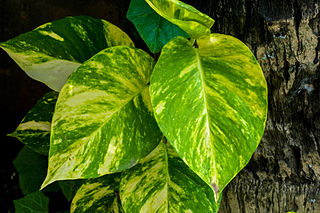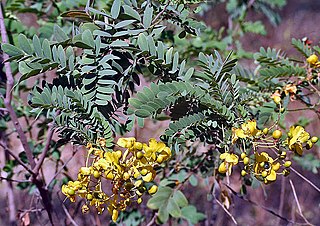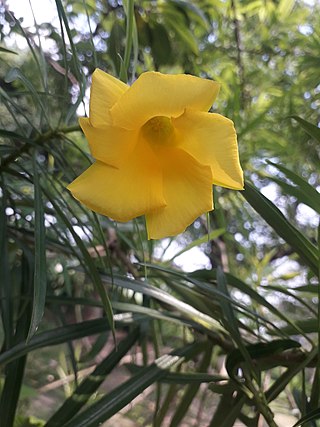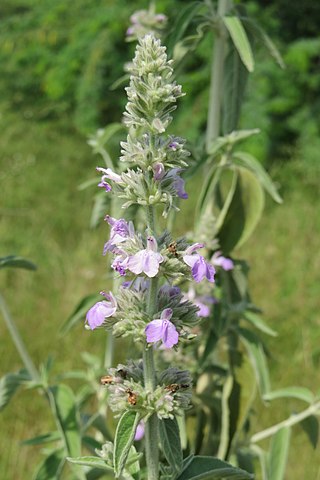
Citrus is a genus of flowering trees and shrubs in the rue family, Rutaceae. Plants in the genus produce citrus fruits, including important crops such as oranges, lemons, grapefruits, pomelos, and limes. The genus Citrus is native to South Asia, East Asia, Southeast Asia, Melanesia, and Australia. Various citrus species have been used and domesticated by indigenous cultures in these areas since ancient times. From there its cultivation spread into Micronesia and Polynesia by the Austronesian expansion ; and to the Middle East and the Mediterranean via the incense trade route, and onwards to Europe and the Americas.

Epipremnum aureum is a species in the arum family Araceae, native to Mo'orea in the Society Islands of French Polynesia. The species is a popular houseplant in temperate regions but has also become naturalised in tropical and sub-tropical forests worldwide, including northern South Africa, Australia, Southeast Asia, South Asia, the Pacific Islands and the West Indies, where it has caused severe ecological damage in some cases.

Withania somnifera, known commonly as ashwagandha or winter cherry, is an evergreen shrub in the Solanaceae or nightshade family that grows in India, the Middle East, and parts of Africa. Several other species in the genus Withania are morphologically similar.

Symplocos is a genus of flowering plants in the order Ericales. It contains about 300 species distributed in Asia and the Americas. Many species grow in humid tropical regions. This is sometimes considered to be the only genus in family Symplocaceae. Plants in this family are shrubs and trees with white or yellow flowers. The oldest fossils of the genus date to the lower Eocene of Europe and North America, with the genus being present in Europe as late as the Pliocene. Fossil seeds of †Symplocos granulosa are frequent in sediment rock layers of the Late Oligocene to the Late Miocene of Denmark, Germany, Austria and Poland. The fossil seeds are very similar to the seeds of the extan southern Chinese species Symplocos glandulifera and Symplocos sulcata. Fossil seeds of †Symplocos paucicostata are known from the Middle Pliocene sediment rock layers in Reuver, the Netherlands and from the Late Pliocene sediment rock layers in northern Italy. The fossil seeds are very similar to the seeds of the extant East Asian species Symplocos paniculata

Justicia adhatoda commonly known in English as Malabar nut, adulsa, adhatoda, vasa, vasaka, is native to Asia.

Ixora coccinea is a species of flowering plant in the family Rubiaceae. It is a common flowering shrub native to Southern India, Bangladesh, and Sri Lanka. It has become one of the most popular flowering shrubs in South Florida gardens and landscapes. It is the national flower of Suriname. Commercially important medicinal plant, used in ayurveda. All parts including flower, leaves and root are taken for various medicinal preparations for skin disease, Diabetes etc

Senna auriculata is a leguminous tree in the subfamily Caesalpinioideae. It is commonly known by its local names matura tea tree, avaram or ranawara, or the English version avaram senna. It is the State flower of Indian state of Telangana. It occurs in the dry regions of India and Sri Lanka. It is common along the sea coast and the dry zone in Sri Lanka.

Curculigo capitulata is a stout herb that belongs to the genus Curculigo. It is known by the common names palm grass, whale back, and weevil lily, and by various synonyms, including Molineria capitulata. It ranges from the Himalayas and eastern India through Indochina, southern China, Malesia, and New Guinea to Queensland and the Solomon Islands. The plant has yellow flowers and oblong, papery pleated leaves with very short stems. In China and India, the plant has traditional uses as medicine to treat diseases such as hemorrhoids, asthma, and consumptive cough. In Southeast Asia, the plant is also used as food wrapping and the fibres are used to make fishing nets, ropes and false hair. However, in recent years Molineria capitulata is more often used as ornamental plants in gardens. In recent studies, M. capitulata was also found to have potential in treating several chronic diseases due to its high antifungal, antioxidant, cytotoxic, thrombolytic, anti-inflammatory, and analgesic activities.

Cascabela thevetia is a poisonous plant native throughout Mexico and in Central America, and cultivated widely as an ornamental. It is a relative of Nerium oleander, giving it a common name yellow oleander.

Rotheca myricoides is a species of flowering plant in the family Lamiaceae. It is native to Africa and widely cultivated elsewhere. In cultivation, it is frequently known by one of its synonyms, such as Clerodendrum myricoides.

Oroxylum indicum is a species of flowering plant belonging to the monotypic genus Oroxylum and the family Bignoniaceae, and is commonly called Indian trumpet tree, oroxylum, Indian trumpet flower, broken bones, Indian caper, scythe tree or tree of Damocles. It can reach a height of 18 metres (59 ft). Various segments of the tree are used in traditional medicine, where it is known as Shyonaka or Sona Patha.

Clerodendrum infortunatum, known as bhat or hill glory bower, is a perennial shrub belonging to the family Lamiaceae, also sometimes classified under Verbenaceae. It is the type species among ~150 species of Clerodendrum. It is one of the most well-known natural health remedies in traditional practices and siddha medicine.

Anisomeles malabarica, more commonly known as the Malabar catmint, is a species of herbaceous shrub in the family Lamiaceae. It is native to tropical and subtropical regions of India, and Sri Lanka, but can also be found in Malaysia, Bangladesh, Myanmar, Bismarck Archipelago, Mauritius, Andaman Islands and Réunion.

Berberis aristata, also known as Indian barberry, Mara manjal (மரமஞ்சள்),"chutro" or "sumbal" ortree turmeric, is a shrub belonging to the family Berberidaceae and the genus Berberis. The genus comprises approximately 450-500 species of deciduous evergreen shrubs and is found in the temperate and sub-tropical regions of Asia, Europe, and America. B. aristata is native to the Himalayas in India and in Nepal. It is also naturally found in the Nilgiri Mountains of southern India and in Sri Lanka.

Salacia reticulata is a flowering plant of the genus Salacia native to Sri Lanka and the Andaman Islands. It grows in dry zone forests in Sri Lanka. In ayurvedic medicine, it is known as kothala himbutu in Sinhala.

Clematis gouriana, or Indian Traveller's Joy, is a liana found in Asia which belongs to the buttercup family (Ranunculaceae). It was described by Roxb. ex DC. and published in Regni Vegetabilis Systema Naturale 1: 138-139, in 1818.

Bhesa indica is a flowering plant tree species in the Centroplacaceae family. It is distributed along the tropical wet evergreen forests of the Western Ghats of India. It is considered synonymous with Bhesa paniculata by some authors.

Chonemorpha fragrans, the frangipani vine or climbing frangipani, is a plant species in the genus Chonemorpha. It is a vigorous, generally evergreen, climbing shrub producing stems 30 m (98 ft) or more long that can climb to the tops of the tallest trees in the forests of Southeast Asia. It has scented, white flowers and large shiny leaves. It is native to China, India, Indonesia, Malaysia, Myanmar, Sri Lanka and Thailand. It is very commonly used in Ayurveda and it is also cultivated mostly worldwide in frost-free places.

Wisteriopsis is a genus of flowering plants belonging to the family Fabaceae. Its native range is China to Indo-China and Temperate Eastern Asia. Wisteriopsis species are twining woody vines, generally resembling species of Wisteria. The genus was established in 2019 as a result of a molecular phylogenetic study, and includes species formerly placed in Millettia or Callerya.

Solena amplexicaulis, commonly known as the creeping cucumber, is a species of plant in the family Cucurbitaceae, native to tropical southern Asia. The fruits, leaves, roots and shoots have use as food and in traditional medicine.





















